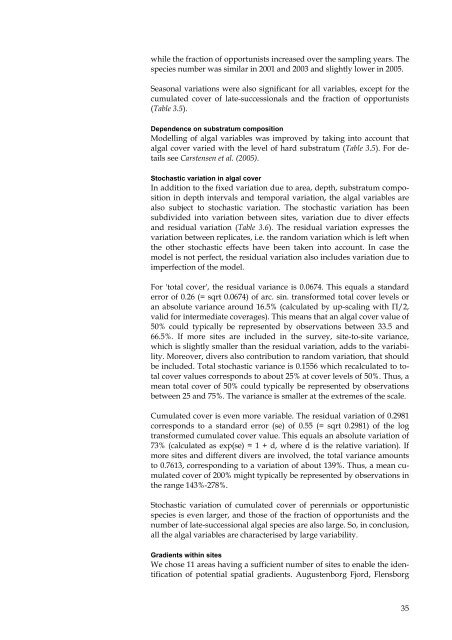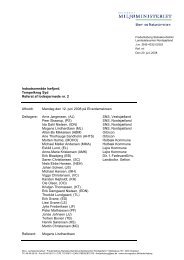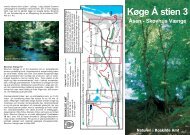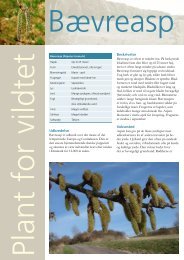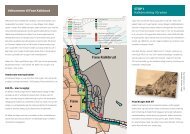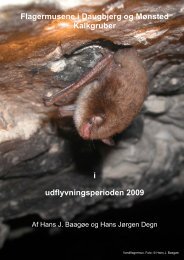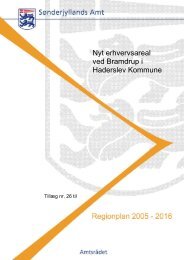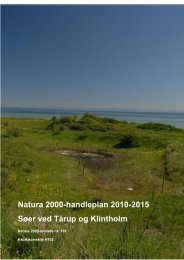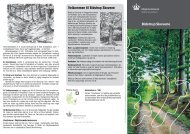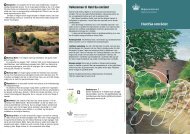Macroalgae and phytoplankton as indicators of ... - Naturstyrelsen
Macroalgae and phytoplankton as indicators of ... - Naturstyrelsen
Macroalgae and phytoplankton as indicators of ... - Naturstyrelsen
Create successful ePaper yourself
Turn your PDF publications into a flip-book with our unique Google optimized e-Paper software.
while the fraction <strong>of</strong> opportunists incre<strong>as</strong>ed over the sampling years. The<br />
species number w<strong>as</strong> similar in 2001 <strong>and</strong> 2003 <strong>and</strong> slightly lower in 2005.<br />
Se<strong>as</strong>onal variations were also significant for all variables, except for the<br />
cumulated cover <strong>of</strong> late-successionals <strong>and</strong> the fraction <strong>of</strong> opportunists<br />
(Table 3.5).<br />
Dependence on substratum composition<br />
Modelling <strong>of</strong> algal variables w<strong>as</strong> improved by taking into account that<br />
algal cover varied with the level <strong>of</strong> hard substratum (Table 3.5). For details<br />
see Carstensen et al. (2005).<br />
Stoch<strong>as</strong>tic variation in algal cover<br />
In addition to the fixed variation due to area, depth, substratum composition<br />
in depth intervals <strong>and</strong> temporal variation, the algal variables are<br />
also subject to stoch<strong>as</strong>tic variation. The stoch<strong>as</strong>tic variation h<strong>as</strong> been<br />
subdivided into variation between sites, variation due to diver effects<br />
<strong>and</strong> residual variation (Table 3.6). The residual variation expresses the<br />
variation between replicates, i.e. the r<strong>and</strong>om variation which is left when<br />
the other stoch<strong>as</strong>tic effects have been taken into account. In c<strong>as</strong>e the<br />
model is not perfect, the residual variation also includes variation due to<br />
imperfection <strong>of</strong> the model.<br />
For 'total cover', the residual variance is 0.0674. This equals a st<strong>and</strong>ard<br />
error <strong>of</strong> 0.26 (= sqrt 0.0674) <strong>of</strong> arc. sin. transformed total cover levels or<br />
an absolute variance around 16.5% (calculated by up-scaling with Π/2,<br />
valid for intermediate coverages). This means that an algal cover value <strong>of</strong><br />
50% could typically be represented by observations between 33.5 <strong>and</strong><br />
66.5%. If more sites are included in the survey, site-to-site variance,<br />
which is slightly smaller than the residual variation, adds to the variability.<br />
Moreover, divers also contribution to r<strong>and</strong>om variation, that should<br />
be included. Total stoch<strong>as</strong>tic variance is 0.1556 which recalculated to total<br />
cover values corresponds to about 25% at cover levels <strong>of</strong> 50%. Thus, a<br />
mean total cover <strong>of</strong> 50% could typically be represented by observations<br />
between 25 <strong>and</strong> 75%. The variance is smaller at the extremes <strong>of</strong> the scale.<br />
Cumulated cover is even more variable. The residual variation <strong>of</strong> 0.2981<br />
corresponds to a st<strong>and</strong>ard error (se) <strong>of</strong> 0.55 (= sqrt 0.2981) <strong>of</strong> the log<br />
transformed cumulated cover value. This equals an absolute variation <strong>of</strong><br />
73% (calculated <strong>as</strong> exp(se) = 1 + d, where d is the relative variation). If<br />
more sites <strong>and</strong> different divers are involved, the total variance amounts<br />
to 0.7613, corresponding to a variation <strong>of</strong> about 139%. Thus, a mean cumulated<br />
cover <strong>of</strong> 200% might typically be represented by observations in<br />
the range 143%-278%.<br />
Stoch<strong>as</strong>tic variation <strong>of</strong> cumulated cover <strong>of</strong> perennials or opportunistic<br />
species is even larger, <strong>and</strong> those <strong>of</strong> the fraction <strong>of</strong> opportunists <strong>and</strong> the<br />
number <strong>of</strong> late-successional algal species are also large. So, in conclusion,<br />
all the algal variables are characterised by large variability.<br />
Gradients within sites<br />
We chose 11 are<strong>as</strong> having a sufficient number <strong>of</strong> sites to enable the identification<br />
<strong>of</strong> potential spatial gradients. Augustenborg Fjord, Flensborg<br />
35


